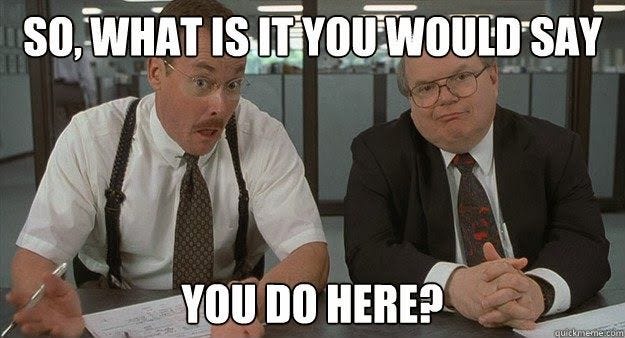Finding out how the sausage is made in the backroom-> a process-driven story

Bryan here again!
As part of my last post, I went through the steps to make a well-driven company, particularly on internal processes. We used RACI, Process Owners, flowcharts to structure a companies’ processes.
Today I would like to talk about how the sausage is made in the backroom.
Insert appropriate business-like sausage meme here:

One of the struggles in implementing a change like this is that you have people from different educational backgrounds and different experiences with processes in general.
For example:
- You will have a person who has worked for corporations and is used to matured-processes,
- A person who has generally worked for startups and small companies, who is not used to process-driven work,
- A person who doesn’t understand how processes intertwine with tech.

One of the struggles of getting everyone on the same page is to make them understand why it’s so important. And to be fair, if you haven’t communicated it well enough, then it’s no wonder they are not cooperating.
Focus on the why. One of the main things I say on a regular basis is ‘to scale effectively’. Scaling a business requires great processes to run. If you don’t intend to scale, you can be less business jargon and more common sense reality. “You will be happier with my job, and less annoyed with wasted time.”
Once they hook into that, then you need to get to the ‘nitty-gritty’.
- “I thought this was my responsibility, but you’re saying it’s yours”.
- “Couldn’t it be better this way?.
- “We should think about it more”.
Or my favourite:

Also, your team will have different ideas on how to approach quality or perfectionist level:
- Some will want it quick and dirty.
- Others will compromise.
- Others will want perfection.
Your job shouldn’t be to have a perfect process at the start. The very essence of this process of processes is to start with something and gradually innovate.
And with different quality and perfectionist levels -> your idea should be to make a process that’s like an MVP (minimum viable product), a bicycle with very minimum to make it work. No flashy stuff, no bells and whistles, just the bare minimum.
But what about responsibilities?

The major roadblock you usually get is how people understand their roles.
If you remember from the RACI matrix, who is responsible, accountable, who should be consulted, and who needs to be informed actually directly changes people’s role descriptions.
It would be a good idea to go through everyone’s roles once you have a more mature process. You will find some discrepancies for sure.
As an example, we wanted to ensure our Salesperson was working 80% of the time on core sales, and 20% on admin. Due to the nature of his involvement in marketing processes, it became apparent that he was over 20% of his admin allocation. Therefore we reduced the need for his input in marketing to ensure this admin portion, and indirectly changed his role description.
Alternatively, I intend to add to people’s role descriptions a specific responsibility towards process improvement.
But I can’t hold onto anything!

I get it, there are many moving parts. You make a process for something, and people’s roles change. Even some people will leave over time, and maybe your process isn’t mature enough to withstand any change.
Making order from chaos is like when it’s a windy day and you are having a picnic and things are blowing away. You should put your foot on the rug first, secure it, and then get every other thing and secure it.
The point here is to at least get something on paper, and move closer to the end goal as the circumstances change.
You make it sound simple…
It’s not. But like anything in life, if you want it to mean something, you have to work on it hard. One of the biggest supports I can give you, as I’ve mentioned before, is when you are getting people on board with an idea, you have two options as a manager
- We will do it this way from now on,
- Or make them understand why it’s so important, and they will be motivated to do it.
What I’ve found is a combination of these work well. You establish some working standard (we do it this way) but don’t force it down their throats. Allow a suitable time for getting onto the idea, and ensure their motivation for the work is pushing them forward, not yours.
Where do I go from here?
If you set up the RACI and Process Owners as I mentioned in the last post, try and now put together a biweekly process meeting, where you go through the processes you have followed and which you haven’t, and some you don’t have a process for.
As an example, I wrote an escalation process last week. We didn’t have one, but it’s important, particularly for new employees, to know who they can escalate to in case of an issue, and have the trust of their managers that they will follow this process.
What’s next for you?
Well, this is the exciting part. I will create a plan for process improvements for 2021 utilizing not just the management team, but the entire company. I will blog more about the journey of making ableneo process-driven in the next coming weeks and months.
Thanks for reading!
Bryan
If you would like to know more about process improvement, email info@ableneo.com with your problem or issue.
Finding out how the sausage is made in the backroom-> a process-driven story was originally published in ableneo Process on Medium, where people are continuing the conversation by highlighting and responding to this story.
